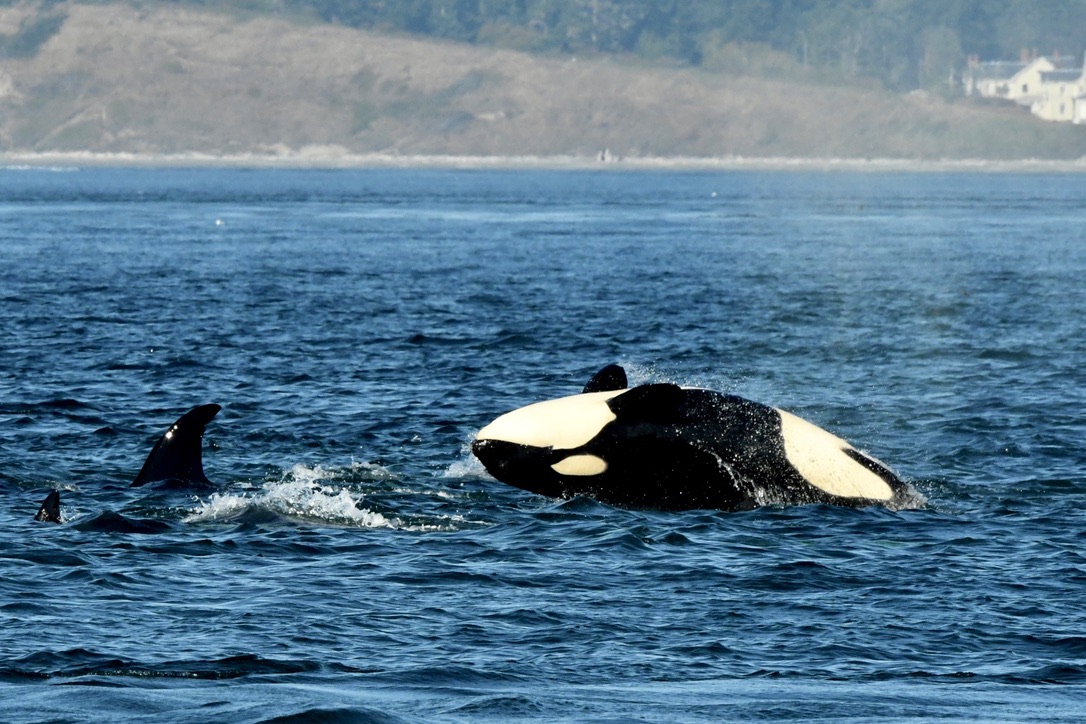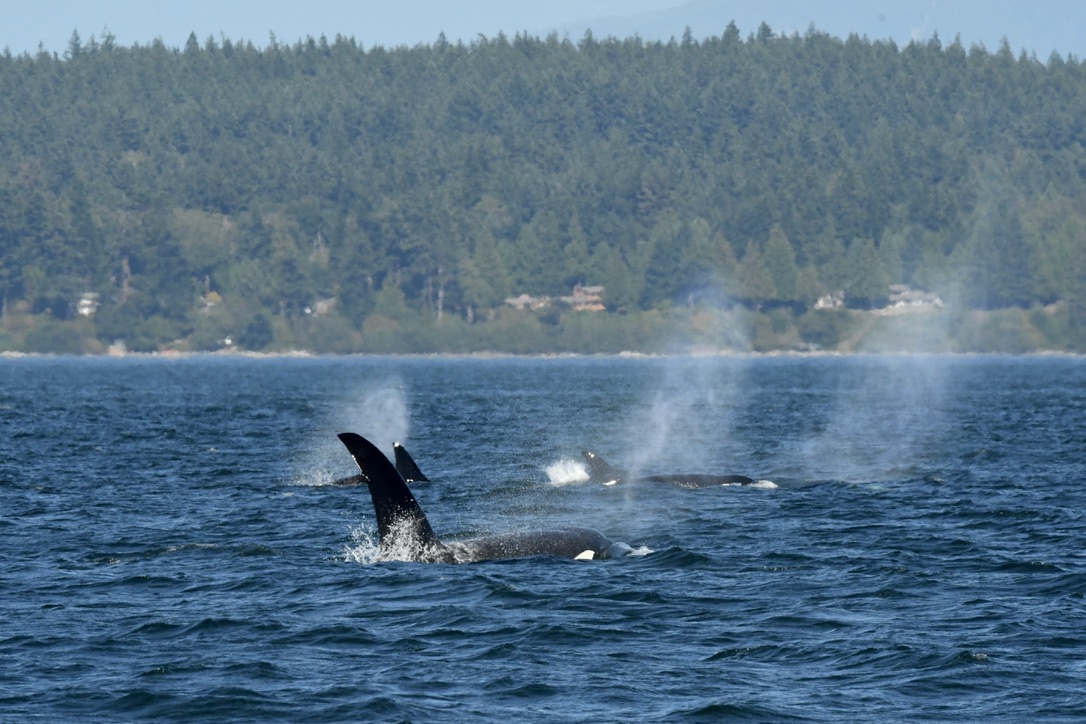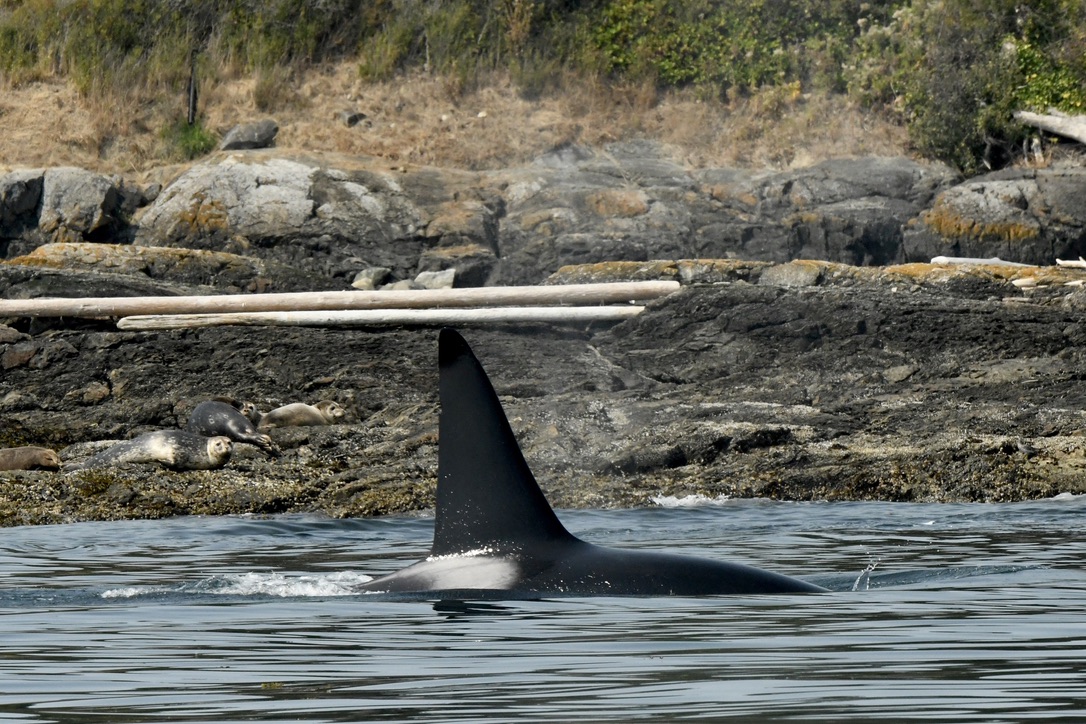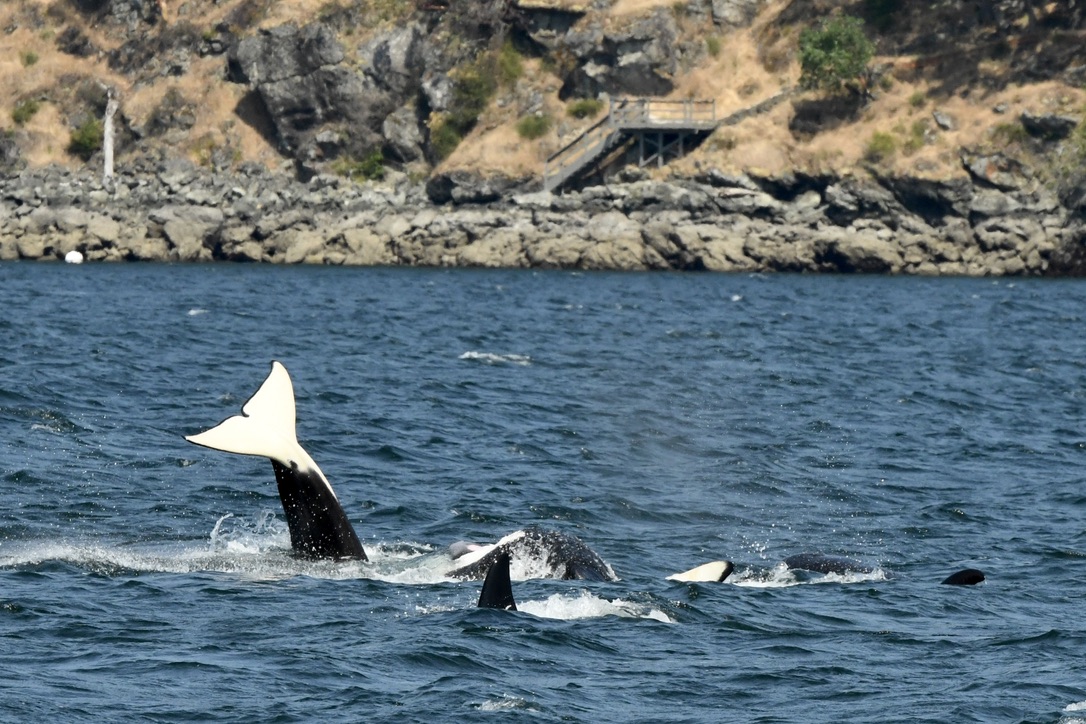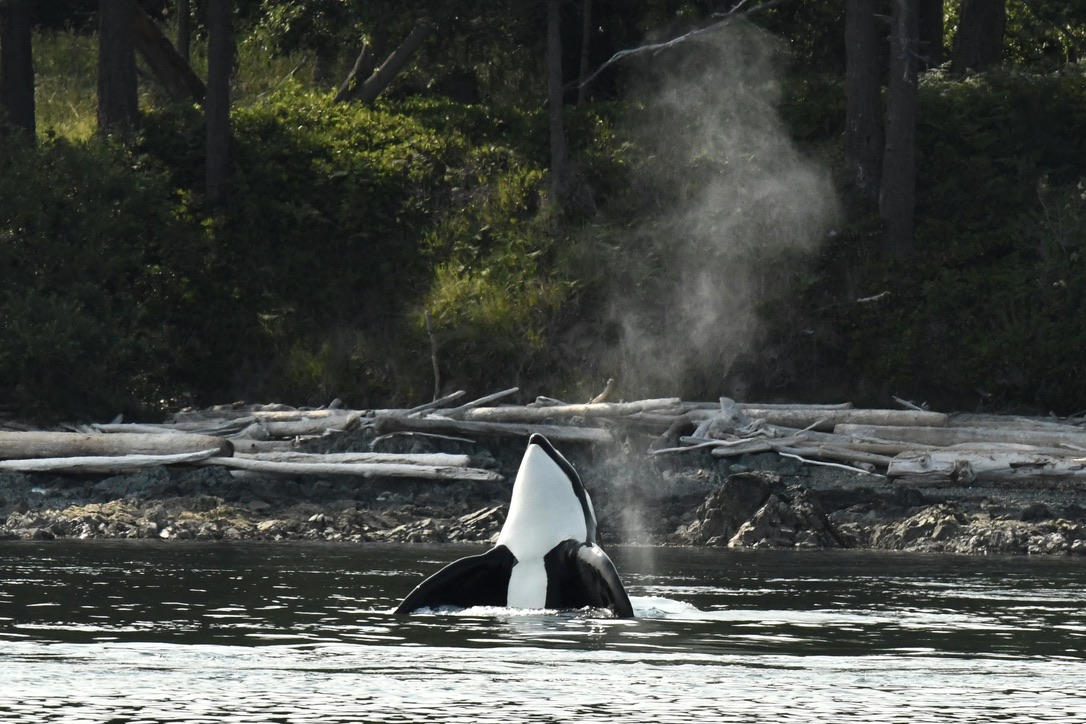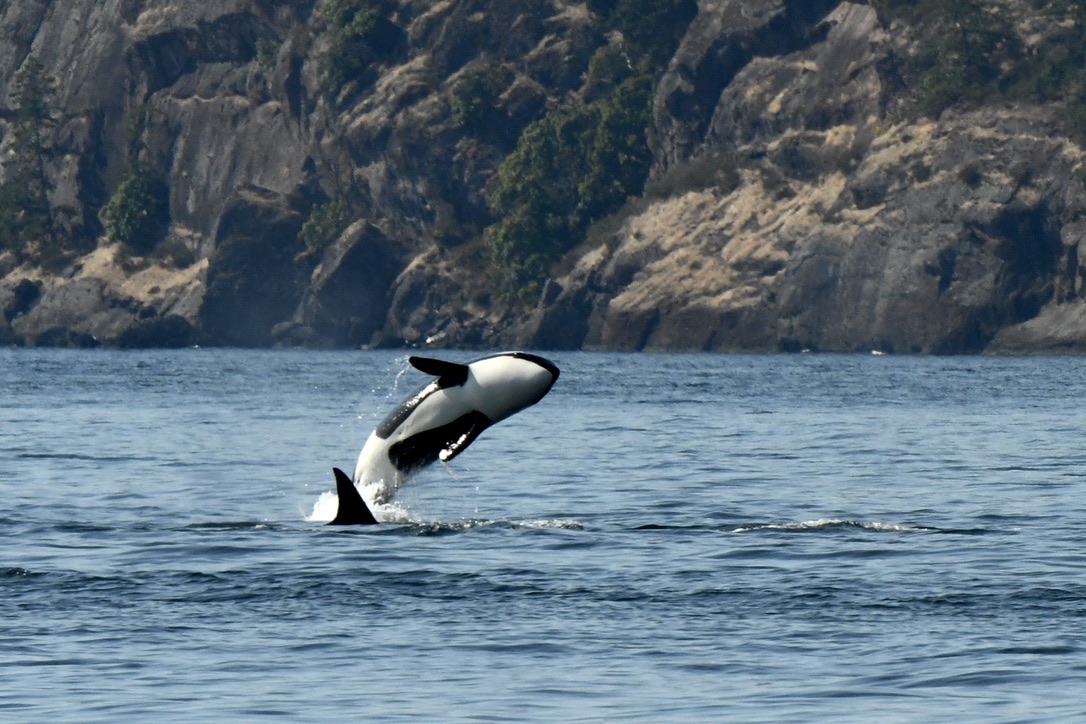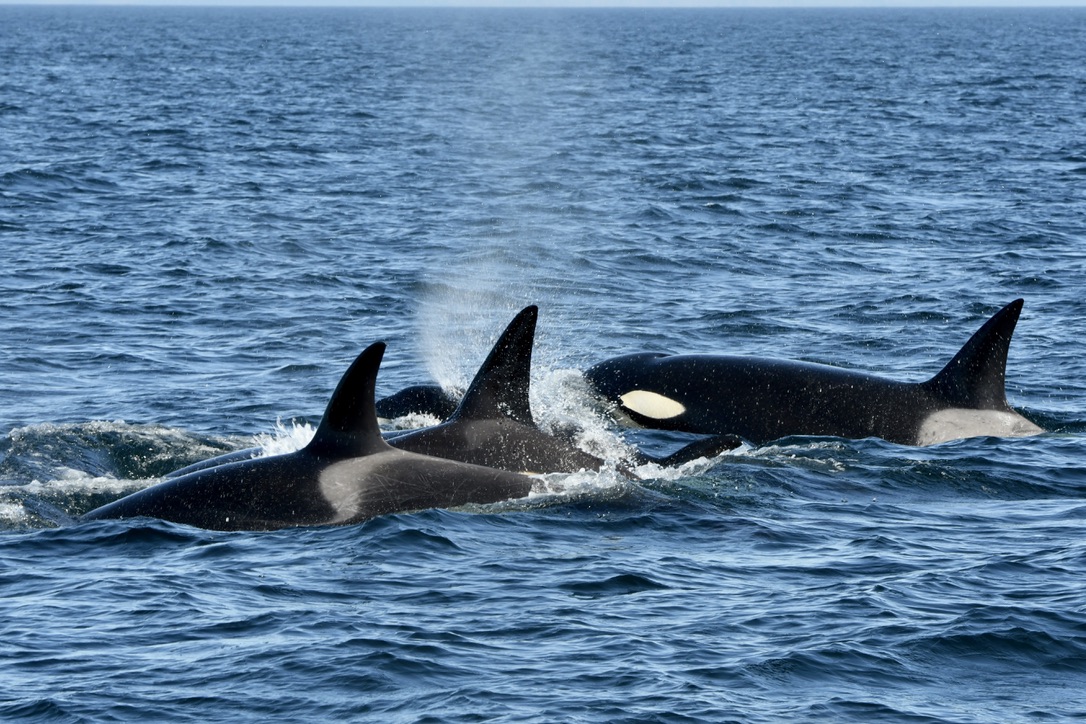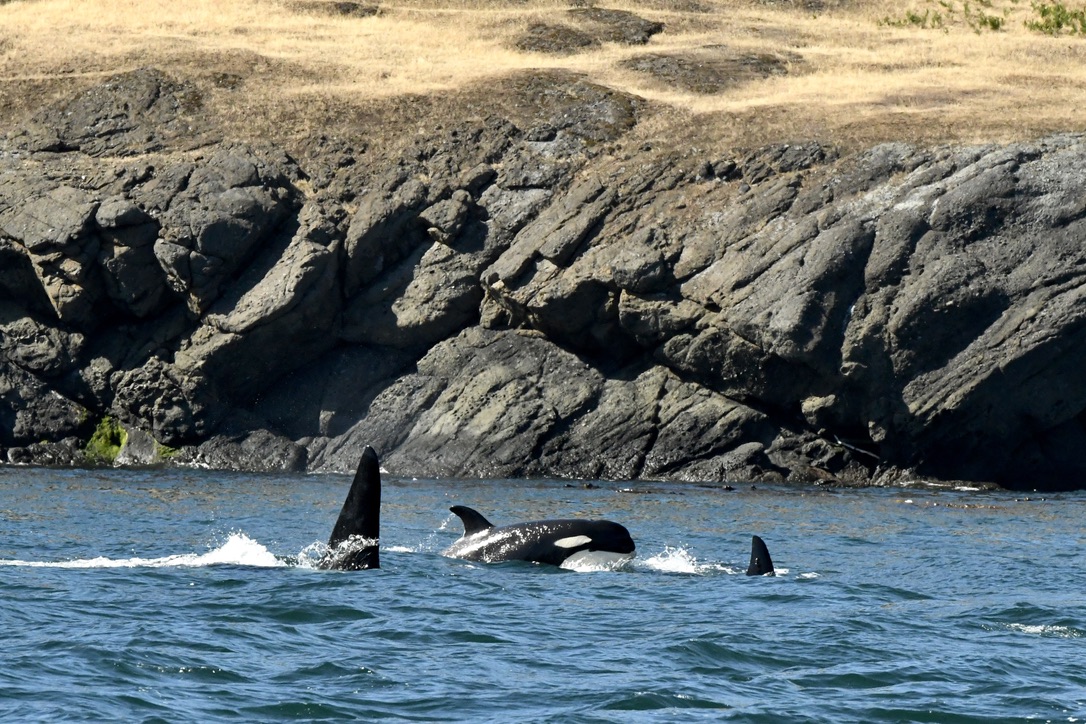Whale Behaviors- Focus on Bigg’s Killer Whales
Every encounter with whales is so unique and we feel fortunate to share in the moments that they crest the surface giving us glimpses of their stories and personalities. There’s still so much beneath the surface that we don’t witness, but the above water experiences are a wonder of their own that keeps us pursuing to learn more about these remarkable creatures!
Cetaceans each have distinct characteristics and behaviors that vary depending on the species and the situation. In this blog, we will be taking a dive into some recognized behaviors of Killer Whales, specifically Bigg’s Killer Whales! To first distinguish, within the Salish Sea, we observe two ecotypes of Killer Whales, “Bigg’s” also known as “Transients” and “Southern Resident” (SRKW). While these two types share many similar features and some similar behaviors, they are actually vastly different, so much so that it would be impossible to generalize their behaviors to the full Killer Whale population. Bigg’s Killer Whales are actually closer related to Antarctic ecotypes than they are to their neighboring SRKW that share the same waters. Some of the key factors that distinguish these two local ecotypes are their social structures, cultural patterns, their diet, and unique dialects. They do not intermingle or cross breed. They are however both extremely intelligent and highly emotional creatures, which is perhaps one of the reasons we are so enraptured by them and drawn to understand and interpret their behaviors.
Researchers have often compared the emotional level of Killer Whales to humans and chimpanzees. In the documentary “Blackfish” it was noted that their emotional intelligence may be at such a level that is more developed and beyond human comparison. Many emotions are measured mostly by responses or actions that we interpret to represent feelings such as joy, grief, stubbornness, protectiveness, and empathy.
Social Structure
Bigg’s travel in their direct family groups referred to as “matrilines,” which typically consists of the mother and her immediate offspring, about 2-7 members. Whereas the common term “pod” is used most often with the SRKW population to describe a large group of about 20 or more orcas of various matrilines which consistently travel together. In a matriline of Bigg’s, eventually the female offspring will reach reproductive age (between about 10-15) and will typically disperse from the group to begin their own matriline. This means they are mostly traveling separate from their mother and siblings once they have calves of their own. The males, however, we call them “mama’s boys” because they typically stay with mom throughout their life.
It is important to note that though these are the social structures we generally witness, that no two matrilines are alike and some don’t follow this exact trend. For any number of reasons that we can hypothesize or create anthropomorphic stories, some males will disperse from their matrilines, and on the other hand some females stay with their original matrilines along with their calves. Whales that have dispersed may also reunite and swim together for stints, or sometimes completely unrelated orcas will be seen in larger groups. Any group of three or more matrilines of Bigg’s swimming together, we’ve coined into a term known as a T-Party (Transient Party). These T-Party groups are typically only seen together for brief occasions, not in the same consistency as a pod. Similar to humans, each family unit’s scenario is unique and the whale’s certainly have mind’s of their own.
Celebration and Feeding
Perhaps one of the most surface active things we love to witness with Bigg’s Killer Whales is their hunting techniques and the celebration that follows. We link the emotion of joy to their celebratory actions including tail slaps, pec slaps, breaching, cartwheels, and basically any other acrobatic act. And of course, they are most commonly active in this joyful behavior at “the dinner table.” Picture them toasting each other to a delicious feast and if you’re a foodie like us, maybe you can also relate!
Bigg’s Killer Whales hunt for marine mammals, predominantly harbor seals, but also steller sea lions, porpoises, or very occasionally smaller whales such as minke’s or juvenile humpbacks. Traveling in their matrilines keeps their group size fairly small, which allows them to be a little more discreet when sneaking up on prey. They may use echolocation when initially seeking prey, but once they are on a hunt they go into stealth mode and remain quiet as the marine mammals can detect their vocalizations. On the trail of prey, the orcas may use a variety of techniques, some of which are unique to a certain group or the habitat they are hunting in. This can consist of fluke, dorsal fin, or pec fin slaps in order to disorient or paralyze their prey, circling “haul out” sites to scare prey into the water, or on rare occasions even beaching themselves to likewise startle prey back to the water. The youngest calf is always at mom’s side learning her every tactic. Once a successful capture has been made, the party begins! The whales may do a series of acrobatic behaviors and begin vocalizing. As they are very family oriented, they will share the prey passing it from mouth to mouth.
We do often have opportunities to witness this incredible celebration, it really just comes down to luck of timing. Bigg’s Killer Whales tend to eat, feast, and feast more, sometimes even taking a harbor seal “to-go.” They have plentiful food sources in the Salish Sea and they never say no to dessert. There doesn’t seem to be a specific trend to timing in which they eat throughout the day or night, so catching these moments is exciting and unpredictable. Needless to say there could be a number of reasons aside from feeding that orca’s may decide to pop out of the water. Just because we see it relating to meal time, doesn’t mean that it can’t happen for other reasons such as cleaning themselves, pure happiness, or reasons we may never know.
Do Whales Experience Grief?
Many orca lovers are familiar with the news breaking story of the SRKW, J35, that carried her deceased calf for over 17 days in what appeared to be an act of mourning. While this particular story was recognized within this particular ecotype, as a whole, orcas are known to be one of the most socially and emotionally intelligent creatures, with the second largest brain in the animal kingdom. Like any of the previous acrobatic behaviors that we associate with celebration, we can also associate actions and behavioral patterns like certain vocalizations, moments of self isolation, and carrying a deceased calf as signs of loss or feelings of grief. It is a little more of a challenging study in eyewitness accounts, as oftentimes the passing of an orca whale is not typically seen by human eyes and is noted mostly by the whale’s absence as “assumed deceased.”
Researchers have recognized on a more scientific level that the insula cortex of an orca’s brain is one of the most elaborate of any brain. This part of the brain is responsible for emotions such as compassion, empathy, perception, motor control, self-awareness, and interpersonal experience. Just the simple fact of knowing that orcas do have such complex levels of emotional intelligence does indicate that yes, they likely do experience grief among many emotions. The small behavioral instances that we do witness as reflections of grief go further to support this theory.
Family is Everything
In many species throughout the planet we study the way they each interact with their environment. Whale researcher and founder of Orca Behavior Institute, Monika Shields, notes in a presentation that we look at their needs for survival in terms of food, habitat, and shelter. Most species have some sort of home base in a physical sense, however, for orcas their “home” is their family. Therefore, they really rely on connection and look out for their family unit in a nurturing manner. They feed together and travel closely, sometimes even synchronizing their surfacing or other movements. Mother orcas are perhaps most admirable as they are the “roof of the house” so to speak. They carry their baby for a gestation period up to 18 months, nurse for up to two years, teach their littlest calves everything they need to know to survive, and even after they are no longer reproducing, they continue to care for their mature males for the rest of their lives. The bond between mother and calf is absolutely precious and in so many ways indescribable as it is with humans and other beings in the animal kingdom. That initial purpose to nurture their young and establish a home unit is so profound and one of the things that we find to be so pure and beautiful with orcas.
There’s So Much More!
Of course there is so much more that is being studied or hasn’t even been discovered yet about orcas and their unique behaviors. Many researchers are constantly seeking to dive deeper into understanding more and sometimes we even witness new patterns or unpredictable moments with these whales that make us wonder or just sit in awe. Come out on a tour to observe, learn more, and discover new experiences with us!
Lorem ipsum dolor sit amet, consectetur adipiscing elit. Ut elit tellus, luctus nec ullamcorper mattis, pulvinar dapibus leo.

